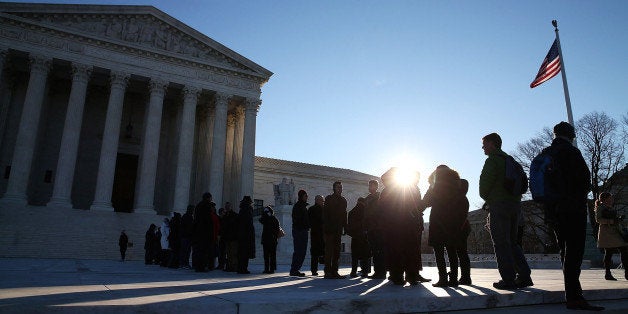
The Court's recent decision (or rather indecision) on Friedrichs v. California Teachers Association, which preserves unions' ability to collect fees from teachers and government workers to help support the cost of collective bargaining, is an obvious victory for unions. What's less obvious is that it's a victory for women, too. And the reason why might surprise you.
Women make up nearly half of the nation's union membership. In addition to having higher wages and more benefits than non-union workers, including a higher likelihood of having paid family and medical leave and paid sick days, women in unions also see a smaller wage gap with their male counterparts.
We've all seen the stats on equal pay. On average, women make 79 cents to every white man's dollar. And for women of color those numbers are much worse: 60 cents for Black women and 55 cents for Latinas. That's why we "celebrate," or at least take a moment to recognize the work that lies ahead to close the pay gap, on Equal Pay Day. In 2016, April 12 is the date women have to work until to be paid what their male counterparts were paid in 2015.
If you haven't yet memorized those depressing figures, then surely you've seen the stories of women (often high-profile women) fighting for equal pay in their industries. Jennifer Lawrence has been an outspoken advocate for equal pay in Hollywood, and just two weeks ago, five decorated members of the United States women's national soccer team filed a federal complaint charging U.S. Soccer with wage discrimination.
To put this all in even simpler terms: at the current rate, women in the U.S. won't see equal pay until 2059. We're slated to have flying cars first. But before you call Doc Brown to see if you can catch a ride to the future in that mythic DeLorean, let's learn from our union sisters about equal pay and how non-union women might hope to close the gender pay gap before we see the first human colony on Mars.
Again, let's look at the numbers: Hispanic women in unions have weekly wages that are 42 percent higher than Hispanic women in non-union jobs. For Black women, it's a 34 percent advantage. We see a 31 percent advantage for white women and a 15 percent advantage for Asian women. The overall union advantage in earnings for women is 31 percent. When we look at the wage gap specifically, we see that on average, women in labor unions earn about 89 cents on the dollar compared with their male counterparts.
Now that's not perfect, and a recent survey shows that even women who are in unions see equal pay as one of their top priorities, but it's clear that women in unions earn higher wages than their non-union counterparts and that the wage gap is smaller for them than women overall.
Why is that? Part of the answer is obvious: unions are able to use the power of collective bargaining to fight for higher wages overall. But that's not the entire picture. Unions also provide their members with more information about their wages. Wage transparency is an important aspect of union membership that isn't often discussed, and it's a policy that nonunion, private-sector employers should also embrace.
I believe in the old adage that sunlight is the best disinfectant. And I think President Obama agrees with me. In January, the President directed the Equal Employment Opportunity Commission, in partnership with the U.S. Department of Labor, to publish a proposal to annually collect summary pay data by gender, race, and ethnicity from businesses with 100 or more employees, and make the aggregate data available to the public by industry. This proposal would cover over 63 million employees.
This step is enormously important for a few reasons: there is no way to enforce the law against pay discrimination if pay information is kept quiet, and it will force employers to look at their own practices and reckon with any pay disparities. Pay transparency will help reduce the gender pay gap.
Before you say that pay transparency is bad for business or makes businesses less competitive, let me stop you. That's a mythWhen Salesforce CEO Marc Benioff voluntarily did an internal audit of his company, he found significant pay inequities and spent $3 million to raise the salaries of women to match those of men. He argues that equality is important for a company's success: "I believe that businesses are more successful when equality is built into the fabric of the company."
At my organization, Make It Work, we would love to see the President's proposal taken further: employer-level salary information should be made fully available, so employees are more directly empowered.
So this Equal Pay Day, I would challenge more employers to take a page from the union playbook and implement greater wage transparency. Taking that step would bring all women, union and non-union alike, closer to equal status in the work place.
Tracy Sturdivant is Co-Founder and Co-Executive Director of Make It Work. For the last 20 years, she has worked to strengthen democracy for all as a leader and strategist inside progressive organizations and philanthropic institutions dedicated to increasing the civic participation of women, people of color and youth.
